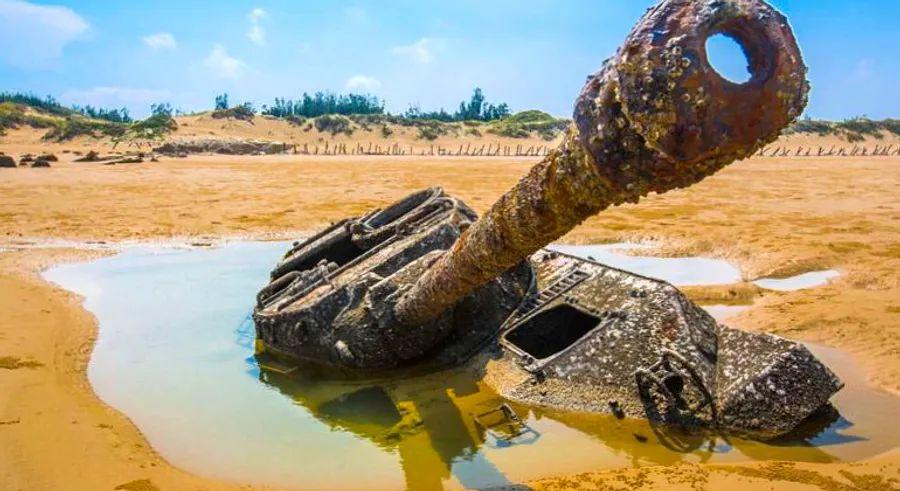Tanks, propaganda, and tourists: Discover Kinmen County, known as ‘Taiwan’s DMZ’

At the northern tip of Taiwan's Kinmen Island, the Beishan Broadcast Wall stands tall, an imposing concrete structure equipped with 48 loudspeakers.
Years ago, this propaganda installation would transmit songs by Teresa Teng, Asia's beloved 'eternal queen of pop,' across the sea to the residents of Xiamen, a city in mainland China, 10 kilometers away.
Constructed in 1967, it served as a critical tool during the Cold War, broadcasting not only songs by Taiwanese music legends but also speeches, some urging mainland soldiers to defect.

In response, loudspeakers in Xiamen echoed their own nationalistic messages across the water.
Why give such significance to this small island?
Since 1949, Taiwan and mainland China have operated under separate governments following the Communist victory in China’s civil war, which forced the Nationalist Kuomintang to retreat to Taiwan. Despite decades of political tension, they still share deep cultural and linguistic ties.
However, Beijing insists that Taiwan is an inseparable part of its territory and strongly opposes any assertion to the contrary.
Kinmen Island is part of Kinmen County, which consists of several islands and islets located in the Taiwan Strait, situated between the mainland Chinese city of Xiamen and Taiwan's main island.
In fact, it is much closer to Xiamen, making Kinmen a strategically significant area for decades, and occasionally, a site of conflict between the two sides.
Named 'Golden Gate,' Kinmen was under military rule for 43 years, from 1949 to 1992. As relations across the Taiwan Strait improved, the broadcasts from the former military base stopped in the early 1990s.
The rich and unique history of Kinmen
In recent years, Kinmen’s islands and islets have gained immense popularity as tourist destinations among mainland Chinese visitors, largely due to the implementation of the 'Mini Three Links' in 2001.
The name refers to the initiation of limited transport, postal, and trade links between Taiwan and the mainland through coastal cities, opening up access to Kinmen County and the nearby Matsu islands.

The traces of Kinmen’s militarized past still populate the landscape, enhancing its allure as a destination for history enthusiasts.
Seong-hyon Lee, director of the Center for Chinese Studies at South Korea’s Sejong Institute, visited Kinmen Island in 2019 and likened it to the Demilitarized Zone (DMZ) between North and South Korea.
The phrase 'Taiwan’s DMZ' is my own expression,” Lee tells Dinogo. “I believe most Koreans visiting the area would share the same sentiment.”
He mentions that the loudspeakers, military barricades on the beaches, and hidden tunnels reminded him of the notorious no-man's land between North and South Korea. However, he also notes that there are significant differences.

“In contrast to the DMZ, Kinmen has developed a stronger identity as a tourist spot rather than a frontline of conflict,” Lee comments.
“While there are still troops stationed and many war-related sites to explore, Kinmen also boasts an old town where visitors can catch a glimpse of the local history,” says Chien-kang Ting.
Military relics, such as the broadcasting wall, have become key attractions for mainland Chinese tourists. The loudspeakers continue to play Teresa Teng’s songs, but now at a much softer volume and solely for tourism purposes.
“In the early days, when Kinmen was under military control, the island relied on its 100,000 soldiers to support the economy,” explains Chien-kang Ting, head of Kinmen County’s Tourism Department.
“When the military government was disbanded and most of the troops withdrew, Kinmen’s economy took a hit. But since Kinmen opened to the public in 1993, tourism has become the island’s economic lifeblood.”
Kinmen Kaoliang Liquor, originally a military-run distillery founded in the 1950s, is now one of Taiwan’s top-selling liquors and a must-visit stop for tourists on Kinmen Island.
Artillery shells are now being repurposed to create the famous Kinmen knives, along with other popular household items and souvenirs for both locals and tourists.
Mini Three Links: Rebuilding connections between mainland China and Taiwan

Before the introduction of the Mini Three Links, there were no direct connections between Taiwan and mainland China, which made Kinmen one of the first places where exchanges between the two sides took place,” says Lee.
“South Korean scholars visit Kinmen to study the 'Mini Three Links' and explore how people on both sides of the strait engage in exchanges and lead normal lives. As a result, Kinmen has become a popular destination for 'study tours' for South Koreans, especially given the lack of civil exchanges between North and South Korea.”
Since the relaxation of restrictions in 2001, Kinmen has continued to open up even further.
Mainland Chinese travelers have been able to visit Kinmen without advance permits since 2015. Prior to the Covid-19 pandemic, they were granted landing permits upon arrival, whether arriving by air or sea – a convenience not extended to those traveling to Taiwan’s main island.
Direct flight routes to Kinmen have also expanded, with numerous airlines offering flights from mainland cities to Kinmen Shangyi Airport. Before the pandemic, over 40 ferries operated daily between Kinmen and the nearby city of Xiamen.
“The opening of these routes marked a historic new chapter for Kinmen’s tourism industry,” says Kinmen Tourism director Ting. “It has become a vital connection between the people of both shores. Kinmen’s local economy now heavily depends on the traffic generated by the Mini Three Links.”
The impact of the pandemic
In 2019, Kinmen welcomed approximately 2.5 million tourists, with around 41% of them coming from mainland China – a number that was expected to keep growing.
However, the Covid-19 outbreak has overshadowed the 20th anniversary of the Mini Three Links in 2020, as all direct ferries and flights were suspended starting in February 2020.
“The number of visitors arriving via the ‘Mini Three Links’ dropped by a staggering 93.96% in 2020,” says Ting.
The local tourism industry came to a halt as well due to the pandemic's effects.
“The first few months were devastating for Kinmen’s tourism industry. Most people were too afraid to fly, so for half the year, our business was completely stagnant,” says Leo Hung, owner of Huang Cuo San Ceng Lou, a bed and breakfast/restaurant known for its Taiwanese taro dishes.
Before the suspension of the Mini Three Links, Kinmen had been seeing 'record-high passenger numbers,' according to a spokesperson from Kinmen Kaoliang Liquor.
“Transportation was almost at full capacity every weekend. With half of Kinmen's visitors coming from the mainland, the halting of ferry services had a profound impact on the local tourism industry,” they added.
However, Kinmen’s tourism industry made a fairly swift recovery after the first few months, as Taiwan quickly contained Covid-19 and local tourism resumed.

“The crisis posed a challenge, but it also gave us the chance to reassess the positioning of our industry,” says Ting.
The tourism office, in collaboration with the government, launched a series of travel vouchers and events aimed at attracting more Taiwanese tourists to Kinmen.
The county also partnered with local operators to introduce Taiwan's first-ever 'cruise to nowhere,' inspired by the region’s popular 'flights to nowhere.'
Additionally, in 2020, the county offered subsidies to young entrepreneurs to help them establish their businesses and revitalize former military districts.
Their efforts paid off. By July, the number of visitors had surged to 184,714. In August 2020, Kinmen welcomed more visitors than it did in the same month of 2019.
According to a spokesperson for Kinmen Kaoliang Liquor, their distillery also saw a surge in visitors, breaking records with over 190,000 guests in 2020.
What lies ahead for Kinmen County?

In light of the impact of Covid-19, members of Kinmen’s tourism sector believe authorities should broaden their offerings and reach a wider range of audiences.
“The pandemic might continue to affect the global landscape for another year or two, so the government needs to create more refined and distinctive tourism experiences in Kinmen,” suggests Hung. “As an island economy, Kinmen also has fewer sea-based tourism offerings compared to neighboring Penghu County.”
Kinmen’s tourism spokesperson agrees, stating that there will be a stronger focus on developing themed and immersive travel experiences – including water-based activities.
Ting shares that Kinmen plans to host a summer music festival that blends arts, music, and history, aiming to create a fresh, youthful tourism brand and revitalize the industry. The plan also includes promoting new natural attractions and highlighting lesser-known spots across the islands.

“Kinmen is rich in natural resources,” says Ting. “It’s also free from light pollution. We aim to introduce night tourism packages and encourage local operators to offer starry night guided tours, allowing travelers to experience the beauty of Kinmen’s natural environment.”
Alongside its military heritage, Ting also emphasizes Kinmen’s unique and otherworldly attractions as key draws for tourists.
“Kinmen boasts many striking and exotic sites. There’s the captivating Shamei 'Morocco' Old Street, Kinmen's own version of Mont Saint-Michel (Jiangongyu Islet), and the 'mini Great Wall' – the Fengshang Patrol Division Fort,” says Ting.
“You’ll feel like you’ve been transported to another world. It will completely change your perception of Kinmen,” adds Ting.
Evaluation :
5/5



